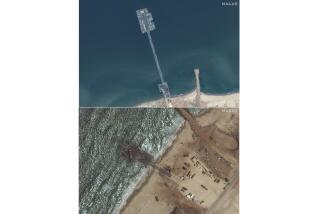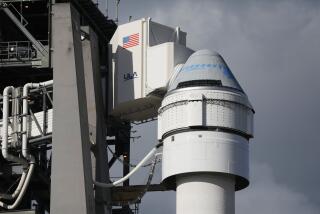Stricken Mir Hasn’t Outlived Its Usefulness
- Share via
MOSCOW — The Russian space station, crippled when its power supply was cut off, drifted helplessly through space. Without electricity, its computer, guidance and communication systems shut down. The temporarily unmanned ship plunged to subzero temperatures.
Six months later, two cosmonauts flew to the lifeless facility on a daring, secret rescue mission. Defying the odds, they docked their space capsule with the frozen ship, boarded it and restarted its power system. They repositioned the station in orbit and thawed out its life-support system, making the craft habitable for years to come.
The year was 1985 and the station was Salyut-7, launched in 1982 by the Soviet Union. “It was a great victory, and it gave us tremendous experience in overcoming seemingly deadlocked situations in space,” recalled Valery Lyndin, a spokesman for the Russian Space Agency.
Today, as two cosmonauts prepare for a risky mission to repair the stricken Mir space station, the 1985 episode illustrates the depth of Russia’s experience with spacecraft and the lengths to which the country will go to maintain its foothold in space.
While holes in Mir’s shell might seem to Americans to doom the ship to the scrap heap, Russian scientists view the craft’s current afflictions merely as temporary setbacks in their 26-year program of operating orbiting stations. Russian officials say they expect to repair the 11-year-old Mir in the next few months and keep it operating for at least three to five more years until its replacement--the international space station being built in cooperation with the United States--is assembled in space and inhabited.
“It is claimed the station [Mir] is a very old one and should have gone off orbit long ago,” said Russian Space Agency Director Yuri N. Koptev. “Nothing of the sort. . . . Today, the station is a unique complex. We are interested in prolonging its stay in orbit to the maximum.”
Invaluable Lessons
Just as the rescue of Salyut-7 established Russia’s ability to revive a dead space station, Russian scientists say the challenge of repairing the punctures Mir incurred during a June 25 accident will provide invaluable lessons for future life in space.
Because the United States is now a partner with Russia in the Mir station, NASA will be a direct beneficiary of knowledge gained in the repair effort. The experience is also likely to generate ideas for improving the design of the forthcoming international space station.
“The fact that these problems have arisen gives us an enormous opportunity to store up experience for future work, for us and for the United States,” said Yuri P. Semyonov, president of the Energiya concern that designs Russia’s space stations. “This is immense experience that cannot be acquired on the ground. It can only be gained in orbit.”
If Russian experts were looking for the chance to learn new lessons in space, they have had more than the usual number of opportunities this year.
In February, a fire broke out on Mir when an oxygen canister exploded. In March, the oxygen generator failed, forcing the crew to rely temporarily on a backup system. In April, antifreeze fumes leaking from a pipe reached dangerous levels before the leak was finally located and fixed.
In the June accident, a collision with a supply ship punched at least two holes in Mir’s Spektr module. To prevent decompression of the entire ship, crew members quickly cut electric cables that ran through the module’s doorway and sealed the door--slashing half the station’s power capacity.
Last month, a crew member training to repair the damaged module inadvertently pulled a plug that shut off the ship’s power, oxygen generator and communications system.
Real Threat to Mir
While the frequent emergencies on Mir have helped create the impression that the station has outlived its usefulness, Russian officials note that most of the problems could have occurred any time during the past 11 years. Only two of the five incidents--the antifreeze leak and the oxygen system failure--were caused by aging components, they say. The fire was sparked by a defective generator, while the collision and power failure were the result of human error.
Further, Russian officials point out that much of Mir is fairly new. Because the station was designed to last five years, many of the ship’s key components have been replaced over time, reducing the risk of breakdown from deteriorating parts. In addition, the Spektr module--where the station’s biggest problems are now centered--was launched only two years ago. Another module, Priroda, was added to Mir last year.
Russian engineers worry that the real threat to Mir’s longevity comes from elements of the station’s plumbing and wiring systems that could prove impossible to replace in the event of a breakdown, said Sergei Gromov, an Energiya spokesman.
For example, thermal pipes that maintain the station at a steady temperature run through Mir’s walls. After one pipe began leaking inside a wall where it could not be repaired, engineers were forced to shut it down and rely on a sole backup pipe. If that pipe springs a leak in the same fashion, it could doom the station.
The crises aboard Mir this year make it easy to overlook Russia’s accomplishments as the world’s undisputed leader in manned spaceflight. The Soviet Union launched its first space station in 1971 and put six more in orbit over the next 15 years before Mir came along. By the time Mir was launched, cosmonauts had already logged more than five years of human habitation in space.
Since the first crew arrived on Mir in March 1986, the station has been constantly occupied; every day the crew spends on Mir, it sets a new record for continuous residence in space.
Among Russia’s many firsts in space, cosmonauts made history in 1986 by flying directly from Salyut-7, a year after it was revived, to the newly launched Mir station.
Unlike the glare of publicity that has focused on Mir’s problems, the failure of Salyut-7 occurred in the secrecy of Soviet times. The loss of the ship and its rescue did not become public until two months after it had already been recovered.
Compared with Salyut-7, Mir’s situation today is not as desperate. Mir has partial power and can support life; its computer and communication systems are functioning; it has maintained its position in orbit except for brief periods.
Dangerous Mission
But the Mir rescue will be difficult and dangerous because one cosmonaut, wearing a bulky spacesuit, must go through a narrow passage into the Spektr module, where broken scientific instruments and spilled chemicals could pose a threat. Cosmonauts must repair power cables severed when the module was sealed. They are scheduled to take five walks outside the ship to find the punctures in the module and patch them.
.
Koptev, the space agency director, said one of the holes in the shell may be at a joint where solar panels are fastened to the ship, potentially making repairs difficult. Engineers are unsure how many more holes there are because the two ships collided a number of times.
“When the cargo ship struck the station, it was like two billiard balls hitting one another,” the director said. “There were all sorts of bumps before the cargo ship withdrew.”
If Spektr cannot be fixed, the station could continue operating indefinitely. But the module’s solar panels are an important source of power for many scientific experiments; when the power cables were cut, the station lost power to operate most experiments on board.
“Our purpose is not to live in conditions of daily repair work but to create conditions in which sufficiently extensive scientific and technological programs can be fulfilled,” Koptev said.
America’s four-year partnership with Russia to operate the Mir-shuttle program is scheduled to end in May.
A precursor to the international space station, the partnership has given the United States the chance to learn from Russia’s experience, establish a lab in space and base its astronauts there. In exchange, the U.S. is paying Russia more than $400 million and has begun using the space shuttle to ferry supplies and people to Mir--expanding the station’s capabilities.
American astronaut David Wolf, who is scheduled to fly to the station in September for a four-month stint, said recent problems like the leaking pipe have prompted engineers to redesign parts of the international space station.
“Mir’s like a time machine, and we’re looking into the future,” Wolf said. “This actually is a wonderful opportunity to have a window on our space station and see how it will look in 10 or 12 years. We’re really getting our money’s worth.”
Russian officials concede that the end of the partnership--and the loss of the shuttle for ferrying duties--will make it harder for Russia to keep operating Mir. But they say that will not deter them from their goal of keeping Mir operating until its replacement is ready.
At Star City, the training facility for the cosmonauts northeast of Moscow, Mir’s two-man repair crew is preparing for the mission by working underwater in simulated weightlessness on a model of the station.
Cosmonaut Anatoly Solovyev is a Mir veteran who has made nine spacewalks, including the world’s record walk of seven hours and five minutes. His comrade, Pavel Vinogradov, is a rocket engineer making his first trip into space.
“I am not afraid,” Vinogradov said earlier this year after the fire, oxygen system breakdown and antifreeze leak had plagued the craft. “We know the Mir station quite well. We know the real technical status of Mir. I am not trembling.”
More to Read
Sign up for Essential California
The most important California stories and recommendations in your inbox every morning.
You may occasionally receive promotional content from the Los Angeles Times.










